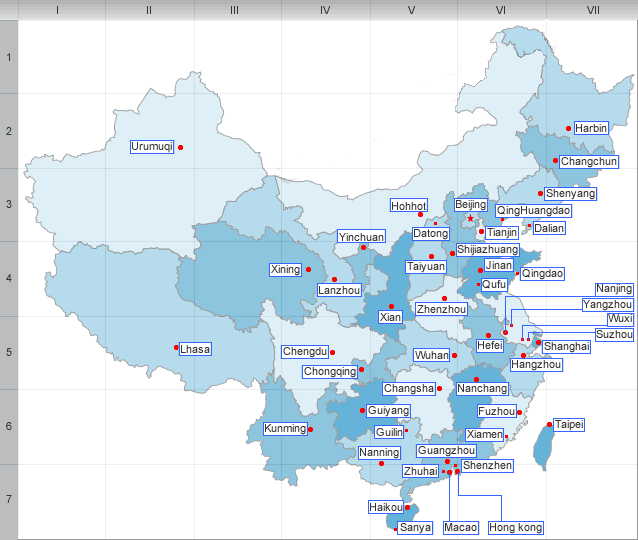Anyang Overview
Overview
The city of Anyang, a prefecture-level city in the northernmost part of Henan Province near the borders to Shanxi Province to the west and Hebei Province to the north, has a history of over 3000 years, and as such is one of the cradles of Chinese civilization. It was the site of the city of Yin, the last capital of the ancient Shang (BCE 1700-1027) Dynasty.* There are many places of historic interest in An'yang, including thirty-six monuments of provincial historical interest and two monuments of national historical interest.
For example, in the ancient city of Ye, just north of An'yang, which, alas, no longer exists (it was subject first to sacking, then was definitively washed away by a flood), the renowned government minister and court advisor during the Warring States (BCE 475-221) period of the Eastern Zhou (BCE 770-221) Dynasty, Ximen Bao, who was also a trained hydraulics engineer, regulated the city's water system through an ingenious system of canals (the same system was later used elsewhere to provide irrigation as well as flood relief). Here is also Fuhao Mausoleum, dedicated to the first Chinese female general who proved herself a brilliant military strategist; here is the Two Emperors Mausoleum (a reference to the two legendary emperors, Zhuanxu and Diku); and here is also the Museum of Yin Ruins, dedicated to broadening our understanding of the ancient city of Yin and the Shang Dynasty in general.
In 1899, inscriptions on so-called oracle bones were discovered in An'yang (oracle bones are large pieces of cracked bone or turtle shell (they were heated and cracked during divination) on which were inscribed – in a unique script that was the precursor to the Chinese character script – the record of the divination). These complex pictographic inscriptions recorded mainly the politics, the economics and the cultural activities during the Yin and Shang Dynasties (note: the later stages of the Shang Dynasty are sometimes referred to as the Yin Dynasty), and are of great historical value. In fact, it is owing to the oracle bone script, which is now a part of the permanent display of the Museum of Yin Ruins, that we know for certain that there indeed existed such a dynasty as the Shang Dynasty, which was based on slavery.
An'yang is therefore a must-see for visitors wishing to observe first-hand the relics and remnants from a part of China's earliest historical period. The Museum of Yin Ruins displays the splendor - and horrors (the ritual execution of humans was part of life at the time) - of the Shang Dynasty and the long history of Huaxia civilization (Huaxia is an alternative – and much older – term used to mean "Chinese" – it is from Hua, meaning splendidly dressed, and Xia, the name for the earliest Chinese civilization, or kingdom). The nearby city of Youli is where the book, Gua Ci ("Explanation of Hexagrams"), was written by King Wen of Zhou (whose personal name was Ji Chang), founder of the Zhou (BCE 1027-221) Dynasty, who was held in captivity here and spent seven years painstakingly writing the Gua Ci (the "Hexagrams" referred to in the Gua Ci are from the I Ching ("Classic of Changes"), and Ji Chang's "explanation" was that the hexagrams beginning with qian ("initiating") revealed (i.e., predicted) the rise of the kingdom of Zhou). The son of King Wen, King Wu of Zhou – who is credited with having toppled the Shang Dynasty, thus becoming the first Zhou Dynasty king – is said to have written the Yao Ci ("Explanation of Horizontal Lines"), which finally made it possible to fully comprehend the contents of the I Ching.
The Temple of Yuefei is dedicated to that hero and and paragon of loyalty, Yue Fei, who proposed that one should be prepared to sacrifice oneself for the sake of the country, and who in fact set that example by offering his own life for king and country. The Two Emperors Mausoleum bears witness to the city of An'yang's long history, while the Grotto of Lingquan Temple, aka Wuanfo Ravine, portrays the prosperity of the Tang (CE 618-907) Dynasty through the various statues that are thoughtfully placed round about the mountain. In addition to these historical highlights, the visitor to An'yang will also enjoy the enchanting natural beauty of An'yang's Small Southern Sea Scenic Area, Pearl Spring Scenic Area, and Linlu Hill Scenic Area as well as Taihang Grand Canyon Scenic Area.
| PREV:Kaifeng Overview | Next:Hebi Overview |



